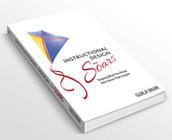

What We Do
The Firefly Group helps people use everyday situations for learning and connecting to the Big Picture. After working with Firefly, you will be energized with specific action steps to achieve your goals.
We do this through training of trainers, leadership development, performance improvement training, strategic planning, and clarification of organizational mission and vision. Our methods are engaging, thought-filled, and results-oriented.
 If
this sounds like a good direction for your organization, let's talk about
how we might collaborate! Please give me a call (802.257.7247) or send an
. - Brian
If
this sounds like a good direction for your organization, let's talk about
how we might collaborate! Please give me a call (802.257.7247) or send an
. - Brian
 Your ETR (Estimated Time to Read): 10 minutes Your ETII (Estimated Time to Implement Ideas): 5 weeks |
Boredom Busters
Boosting Engagement in Meetings, Classrooms, and TrainingsDate: Monday, September 23, 2013
Time: 9:00 - 3:00; 8:30 Registration
Place: Chelmsford, MA
Cost: $295
Tired of being tired in meetings, trainings, and at work? Plan to attend this workshop offered by Brian Remer. Gain practical insights about motivation and learn techniques you can use tomorrow to increase commitment in the workplace.
Read the details and register HERE.
July 2013
|
Say
It Quick |
Discoveries bits of serendipity to inspire and motivate |
Ideas fuel for your own continuous learning |
Activities tips and tricks you can try today |
| Life Lessons | Two Books for Better Training | Strengths and Influence |
Learning opportunities are all around us. Find out how to maximize your teaching abilities beginning with this story in exactly 99 words.
Life Lessons
For 3 years I taught English in Egypt. Once a week, I volunteered to tutor a group of disadvantaged teens. But that had been 10 years ago and now I was back for a visit, touring a new school.Entering the computer classroom, the professor introduced himself. "I'm Emad, one of the kids you tutored. You know, I didn't learn any English from you." I was crushed, until he added, "But I did learn how to be a good teacher!"
I never realized I'd given that lesson!
We seldom know the real lessons we may be teaching.
Two Books for Better Training
The 99-Word Story this month suggests that there is more to teaching than knowing a set of information that students need to learn. How you teach is also important. I'll save that discussion for the Ideas column of this News Flash because right now I'd like to share two resources that, if I'd had them years ago, Emad might actually have learned some English!
 The
first is Designing Business Training for Fun and Results by Susan
Otto (© 2012 Susan Gamel Otto, 976 Winding Way, Kenton Hills, KY 41011).
The
first is Designing Business Training for Fun and Results by Susan
Otto (© 2012 Susan Gamel Otto, 976 Winding Way, Kenton Hills, KY 41011).
Otto's book centers on a structure for training that can be used like a template. This structure includes eight components that Otto describes in detail:
After explaining how these eight features work together to make a meaningful learning session, Otto spends the second half of her book on such things as flow, timing, learning activities, handouts, and action planning. She concludes with a job aid and action plan for readers ready to dive into their next training design.
 The
second resource is Instructional Design that Soars by Guila
Muir (© 2013 Guila Muir, Book Publishers Network, PO Box 2256, Bothell,
WA 98041).
The
second resource is Instructional Design that Soars by Guila
Muir (© 2013 Guila Muir, Book Publishers Network, PO Box 2256, Bothell,
WA 98041).
Muir uses the analogy of a kite for how to construct a training session.
The familiar analogy adds a playful focus to training design and makes the process easier to understand for people new to the field. Each element of the kite is further detailed so that designers are encouraged to include introductions, transitions, materials, and activities. By stringing related "kites" together, Muir explains how a longer training event can be built in a modular fashion.
The two books have many similarities. Both give a nod to the traditional steps of instructional design known as ADDIE (Analysis, Design, Development, Implementation, Evaluation). But both diverge from ADDIE's linear approach to offer a simpler model of design that allows for spontaneity and the "messiness" of the creative process.
Both books also acknowledge the importance of adult learning theory, advocate the use of experiential learning activities, address the question of when training should be used, and include tips and suggestions for teaching without lecturing.
A valuable feature the books share is their workbook format. Each provides provocative questions, worksheets, and whitespace for readers to build their training design as they read the book. This encourages readers to assimilate the books' lessons as they are being read. It's like being tutored by the author.
Whether you are a seasoned subject matter expert or a young English teacher, these two books contain valuable "how to" information for anyone entering the "foreign culture" of training.
The Same but Different
I am pleased to know both authors highlighted in this month's Discovery column. All three of us share a commitment to active learning and we are also members of the North American Simulation and Gaming Association (NASAGA). So, for me, there is no surprise that, though there are similarities in Susan's and Guila's books about training design, the differences in their approach to design hinge on their personal interests.
 Susan
Otto has gained a reputation as a designer of ready-to-use training packages.
Her business, Training-Modules.com
(http://www.training-modules.com/), has focused on the development of training
units that anyone with a modest amount of comfort in front of a group can
present seamlessly. As a result, the advice in her book, Designing Business
Training for Fun and Results, tends to be weighted more toward the writing
of solid training plans. There are suggestions for formatting handouts, increasing
legibility of PowerPoint slides, and creating job aids for optimal usability.
Susan
Otto has gained a reputation as a designer of ready-to-use training packages.
Her business, Training-Modules.com
(http://www.training-modules.com/), has focused on the development of training
units that anyone with a modest amount of comfort in front of a group can
present seamlessly. As a result, the advice in her book, Designing Business
Training for Fun and Results, tends to be weighted more toward the writing
of solid training plans. There are suggestions for formatting handouts, increasing
legibility of PowerPoint slides, and creating job aids for optimal usability.
 On
the other hand, Guila Muir is well known as a coach for public speakers. She
publishes a blog
(http://www.guilamuir.com/train-the-trainer-articles/) with tips and suggestions
for better performance for anyone who might be asked to speak in front of
a group. Her book, Instructional Design that Soars, places more emphasis
on designing training so that you, the presenter, can be more comfortable
while on your feet. Subject matter experts, especially, will find her book
helpful to avoid the trap of trying to teach everything they know. Instead,
SMEs can make the transition to become a trainer who helps people learn what
they need to know.
On
the other hand, Guila Muir is well known as a coach for public speakers. She
publishes a blog
(http://www.guilamuir.com/train-the-trainer-articles/) with tips and suggestions
for better performance for anyone who might be asked to speak in front of
a group. Her book, Instructional Design that Soars, places more emphasis
on designing training so that you, the presenter, can be more comfortable
while on your feet. Subject matter experts, especially, will find her book
helpful to avoid the trap of trying to teach everything they know. Instead,
SMEs can make the transition to become a trainer who helps people learn what
they need to know.
My grandfather, full of his own brand of wisdom, would have said these two books about training design are "the same thing only different." And he would have been right. But a close reading of the work of Susan and Guila reveals that each has approached the subject of training from their particular strengths: either writing or speaking. Though there is much overlap in their books, the authors' ideas diverge along their personal interests and experiences. Those individualized perspectives become the foundation for the singular contribution to teaching, training, and learning that they have been able to make.
Both authors agree: Learning should be highly relevant and it should be fun! To insure both, focus on the details, then share your individuality.
Strengths and Influence
Knowing all the information, being organized, preparing materials, practicing, summarizing, these are all critical elements of a positive learning experience in any setting. However, as the 99-Word Story suggests, all these elements may have little to do with what people actually learn from your time as a teacher. Sometimes the lesson people take away has more to do with who you are and how you teach than the facts, information, attitudes, and skills that are the overt subject of the training.
With this observation in mind, I'd like to invite you to consider your role as a teacher or trainer. Whether training is a formal part of your job or a responsibility that only falls upon you occasionally, people will learn from both your knowledge and your approach. And if you are a team member, colleague, peer, or parent, you are probably teaching some lessons without being aware of it.
To become more mindful of your potential as an informal instructor, write your answers to these questions:
Reflecting on your answers to these questions will begin to tell you the subtle but profound lessons you may be teaching just by being who you are. Even better, ask a close friend to share their observations of you in times of stress, change, and conflict. The insights you gain will enable you to capitalize upon your strengths and maximize your personal influence.
If you have found this line of thinking helpful, !
Thanks and, whether you spend hours designing it or you are unaware it's even happening, good luck teaching your next lesson!
|
Whether you need a keynote speaker, or help with strategic planning, performance improvement, or training facilitators and trainers in your organization, I look forward to your call (802.257.7247) or . -- Brian |
Read previous
issues. Click Library!
To add or delete your name to our mailing list, email
with a short note in the subject line.
I want this newsletter to be practical, succinct, and thoughtful. If you have suggestions about how I can meet these criteria, please let me know! Send me an with your thoughts and ideas.
Home
| Services
| Products
| Mission
| Ideas |
The Group
| The Buzz
(c)
2013 The Firefly Group